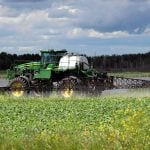CNS Canada — What’s really happening with this year’s flax crop is going to be revealed in the next few weeks as farmers get into their fields.
Statistics Canada predicted in a production report, released Aug. 31, that both Saskatchewan’s and Canada’s flax production this year would be 13.7 per cent less than in 2016. However, its forecast was based on data collected in July.
With most of the flax crop just now starting to be harvested, many are wondering if making estimates now might be a bit early.
Read Also

U.S. livestock: Cattle futures sink on concerns over Trump’s push to lower prices
Chicago | Reuters – U.S. cattle futures tumbled on Monday, extending a steep slide after President Donald Trump complained last…
For Shane Stokke, who farms near Watrous, Sask. and chairs the Saskatchewan Flax Development Commission, the days ahead will tell the real story, but he figures StatsCan is going to be pretty close.
“Our area is not a bad flax crop. It doesn’t look too bad, but some areas are dried out and I think their yields are going to be down. So (the StatsCan report) might be a bit on the low side, but I don’t think it’s that far out.”
Yields overall look variable, he added, but on the quality side, many producers should be happy if current expectations prove true once harvest begins and if the weather stays good.
StatsCan’s numbers have production in Saskatchewan, by far the largest flax-producing province, falling to 409,000 tonnes this year from 473,700 in 2016.
Nationwide, flax production is expected to fall to 507,000 tonnes from 588,000 tonnes a year ago, according to the StatsCan report. Manitoba’s production was predicted to fall 41.7 per cent to 34,800 tonnes from 59,700. Alberta’s production was forecast to come in at 63,500 tonnes this year, up 16.3 per cent from 54,600 in 2016.
In a separate report on available stocks in Canada, StatsCan reported an inventory carryout of 191,000 tonnes as of July 31, compared to 277,000 tonnes at the same time in 2016.
For Rachel Evans, extension agronomist with the Flax Council of Canada, an average flax yield around the Prairies could be about 17 bushels per acre, which would be below typical prairie yields of 22 bu./ac.
She blamed the yield loss on dry conditions in parts of Saskatchewan, but pointed out the key flax-growing areas are outside the worst of the drought-hit regions, with significant flax acreage typically in east-central Saskatchewan, which was OK for moisture.
“I don’t anticipate yields to be really low there. Certainly Manitoba, with our limited acres, predictions from Stats Canada were about 20,000 acres off from what actually went in the ground.”
Evans felt estimating the size of the flax crop now is premature, given that the flax harvest has just barely begun, but said the crop she has seen looks good so far.
That’s based on conditions in Manitoba, which did not experience the same moisture problems as Saskatchewan and Alberta, she added.
For Stokke, the real challenge for flax growers is going to be competition from the large crops expected in Russia and Kazakhstan.
“I think they are going to be the dictator on the price,” he said, adding he would expect prices to stay at around $11.50-$12.50 per bushel through most of the 2017-18 marketing year.
— Terry Fries writes for Commodity News Service Canada, a Winnipeg company specializing in grain and commodity market reporting. Follow CNS Canada at @CNSCanada on Twitter.
















